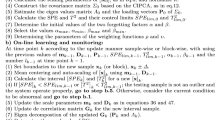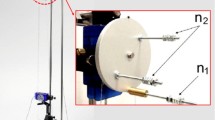Abstract
This paper presents a new interval diagnosis method to detect and isolate actuators faults of an autonomous spacecraft involved in the rendez-vous phase of the Mars Sample Return (MSR) mission. The proposed diagnosis approach is based on the Vertices Principal Component Analysis (VPCA) as an extension of the classical PCA method to interval data. To ensure the feasibility of the proposed Fault Detection and Isolation (FDI) approach, a set of interval data provided by the MSR “high-fidelity” industrial simulator and representing the opening rates of the spacecraft thrusters has been considered. The results have proven the efficiency of the proposed FDI approach in the diagnosing process assuring the detection and the isolation of both single and multiple faults.
Similar content being viewed by others
References
S. Tong, B. Huo, and Y. Li, “Observer-based adaptive decentralized fuzzy fault-tolerant control of nonlinear largescale systems with actuator failures,” IEEE Transactions on Fuzzy Systems, vol 22, no. 1, pp. 1–15, 2014.
Y. Hou, Q. Cheng, A. Qiu, and Y. Jin, “A New Method of Sensor Fault Diagnosis for Under-Measurement System based on Space Geometry Approach,” International Journal of Control, Automation, and Systems, vol. 13, no. 1, pp. 39–44, 2015.
Z. Q. Wu, Y. Yang, and Ch. H. Xu, “Adaptive Fault Diagnosis and Active Tolerant Control for Wind Energy Conversion System,” International Journal of Control, Automation, and Systems, vol. 13, no. 1, pp. 120–125, 2015. [click]
S. Tong, S. Sui, and Y. Li, “Fuzzy Adaptive Output Feedback Control of MIMO Nonlinear Systems With Partial Tracking Errors Constrained,” IEEE Transactions on Fuzzy Systems, vol 23, no. 4, pp. 729–742, 2015.
D. Ichalal, B. Marx, J. Ragot, and D. Maquin, “Fault detection, isolation and estimation for Takagi-Sugeno nonlinear systems,” Journal of the Franklin Institute, 2013.
N. B. Hoang and H. J. Kang, “A Model-based Fault Diagnosis Scheme for Wheeled Mobile Robots,” International Journal of Control, Automation, and Systems, vol. 12, no. 3, pp. 637–651, 2014. [click]
H. J. Liao and S. Z. Huang, “The fault diagnosis for centrifugal compressor based on time series analysis with neutral network,” Proceedings of the 3rd International Conference on Advanced Computer Theory and Engineering (ICACTE’ 10), Chengdu, China, August 2010.
L. Marton, “Actuator Fault Diagnosis in Mechanical Systems-Fault Power Estimation Approach,” International Journal of Control, Automation, and Systems, vol. 13, no. 1, pp. 110–119, 2015. [click]
H. M. Odendaal and Th. Jones, “Actuator fault detection and isolation: An optimised parity space approach,” ELSEVIER, Control Engineering Practice, vol. 26, pp. 222–232, 2014. [click]
J. Lee and Ch. Park, “Cascade Filter Structure for Sensor/Actuator Fault Detection and Isolation of Satellite Attitude Control System,” International Journal of Control, Automation, and Systems, vol. 10, no. 3, pp. 506–516, 2012. [click]
M. Bonfè, P. Castaldi, W. Geri, and S. Simani, “Fault detection and isolation for on-board sensors of a general aviation aircraft,” International Journal of Adaptive Control and Signal Processing, vol. 20, no. 8, pp. 381–408, October 2006. [click]
Ch. Gao and G. Duan, “Fault diagnosis and fault tolerant control for nonlinear satellite attitude control systems,” Aerospace Science and Technology, vol. 33, no. 1, pp. 9–15, 2014.
Y. K Ma and H. B. Ji, “Robust Control for Spacecraft Rendezvous with Disturbances and Input Saturation,” International Journal of Control, Automation, and Systems, vol. 13, no. 2, pp. 353–360, 2015. [click]
D. Henry, E. Bornschlegl, X. Olive, and C. Charbonnel, “A model-based solution for fault diagnosis of thruster faults: Application to the rendezvous phase of the Mars Sample Return mission,” Proc. of 4th European Conference For Aerospace SCiences, FD & GNC Model-Based Fault Detection And Diagnosis For Aerospace Systems: PART I, 2011.
S. Ding, P. Zhang, E. Ding, S. Yin, A. Naik, P. Deng, and W. Gui, “On the Application of PCA Technique to Fault Diagnosis,” ELSEVIER, Tsinghua Science & Technology, vol. 15, no. 2, pp. 138–144, April 2010.
S. M. Zanoli and G. Astolfi, “Application of a Fault Detection and Isolation System on a Rotary Machine,” Hindawi, International Journal of Rotating Machinery, 2013.
M. F. Harkat, G. Mourot, and J. Ragot, “An improved PCA scheme for sensor FDI: application to an air quality monitoring network,” Journal of Process Control, vol. 16, pp. 625–634, 2006. [click]
F. Kimmich, A. Schwarte, and R. Isermann, “Fault detection for modern Diesel engines using signal-and process model-based methods,” ELSEVIER, Control Engineering Practice, vol. 13, no. 2, pp. 189–203, February 2005.
J. Mina and C. Verde, “Fault detection for large scale systems using dynamic principal components analysis with adaptation,” International Journal of Computers, Communications & Control, vol. 2, no. 2, pp. 185–194, 2007.
C. Lee, S. W. Choi, and I. B. Lee, “Sensor fault identification based on time-lagged PCA in dynamic processes,” ELSEVIER, Chemometrics and Intelligent Laboratory Systems, vol. 70, no. 2, pp. 165–178, 2004.
Y. Tharrault, G. Mourot, J. Ragot, and D. Maquin, “Fault detection and isolation with robust principal component analysis,” International Journal of Applied Mathematics and Computer Science, vol. 18, no. 4, pp. 429–442, 2008. [click]
F. Palumbo and C. N. Lauro, “A PCA for interval valued data based on midpoints and radii,” In New Developments in Psychometrics, H. Yanai, A. Okada, K. Shigematu, Y. Kano and J. J. Meulman, eds. Japan, Springer-Verlag, pp. 641–648, 2003.
P. Giordani and H. A. L. Kiers, “A comparison of three methods for principal component analysis for fuzzy interval data,” Computational Statistics & Data Analysis, vol. 51, pp. 379–397, 2006. [click]
A. D. Chouakria, L. Billard and E. Diday, “Principal component analysis for interval-valued observations,” Statistical Analysis and Data Mining: The ASA Data Science Journal, vol. 4, no. 2, pp. 229–246, April 2011.
S. Valle, W. Li and S. Qin, “Selection of the number of principal components: The variance of the reconstruction error criterion with a comparaison to other methods,” Industrial & Engineering Chemistry Research, vol. 38, pp. 4389–4401, 1999. [click]
S. Wold, “Cross-validatory estimation of the number of component in factor and Principal Components models,” Technometrics, vol. 20, no. 4, pp. 397–405, Novembre 1978.
S. J. Qin and R. Dunia, “Determining the number of principal components for best reconstruction,” Journal of Process Control, vol. 10, pp. 245–250, 2000. [click]
M. Tamura and S. Tsujita, “A study on the number of principal components and sensitivity of fault detection using PCA,” Journal of Computers and chemical Engineering, vol. 31, pp. 1035–1046, 2007. [click]
Y. Tharrault, G. Mourot, J. Ragot and D. Maquin, “Sensor fault detection and isolation by robust principal component analysis,” Fault Detection, Wei Zhang (Ed.), In-Tech, Chap. 16, 2010.
G. E. P. Box, “Some theorems on quadratic forms applied in the study of analysis of variance problems: Effect of inequality of variance in one-way classification,” The Annals of Mathematical Statistics, vol. 25, pp. 290–302, 1954.
A. Neumaier, Interval Methods for Systems of Equations, Cambridge University Press, 1990.
R. Dunia and S. Qin, “A subspace approach to multidimensional fault identification and reconstruction,” American Institute of Chemical Engineers Journal, vol. 44, no. 8, pp. 1813–1831, 1998.
A. Ben Aicha, G. Mourot, K. Benothman. and J. Ragot, “Determination of Principal Component Analysis models for sensor fault detection and isolation,” International Journal of Control, Automation and Systems, vol. 11, no. 2, pp. 296–305, 2013. [click]
EADS Astrium Mars Sample Return Study Executive Study, Issue 1, CI Code TN/MSR/AST/101, UK Export Control Rating: 9E001, 2004.
R. Oberto, “Mars Sample Return, a concept point design by Team-X (JPL’s Advanced Project Design Team),” IEE Aerospace Conference, vol. 2, pp. 2–559–2-573, 2002.
U. Derz and W. Seboldt, “Mars sample return mission architectures utilizing low thrust propulsion,” Acta Astronautica, vol. 77, pp. 83–96, August-September 2012.
Author information
Authors and Affiliations
Corresponding author
Additional information
Recommended by Associate Editor Guang-Hong Yang under the direction of Editor Duk-Sun Shim. This work has been developed in the project SIRASAS (Strategies Innovantes et Robustes pour l’Autonomie des Systemes Aeronautiques et Spatiaux) supported by the Fondation de Recherche pour l’Aeronautique et l’Espace.
Imen Gueddi received her engineering degree in Industrial Electronics in 2012 and her Msc. degree in intelligent and communicating systems in 2013 from the National Engineering School of Sousse (ENISo), Tunisia. She is currently a Ph.D. student in the same university. Her interests research include fault diagnosis and interval arithmetic.
Othman Nasri was born in Kasserine, Tunisia. In July 2004 and December 2007 correspondingly, he received his Post-Graduate Degree in Control Systems and Applied Informatics from Ecole Centrale de Nantes-France and his Ph.D. degree in Signal Processing and Telecommunications from CentraleSupelec of Rennes-France. From 2008 to 2010, he was a research Engineer in Embedded Control Systems in CNRS-University of Paris-Sud 11 / INRIA Saclay Île-De-France. He is now an Associate Professor / Director of the Department of Industrial Electronics of National Engineering School of Sousse, university of Sousse - Tunisia. His research interests include fault diagnosis and FTC, process modeling and monitoring, multivariate statistical approaches, safety verification of hybrid systems.
Kamal Benothman received the license in Mechanical and Energetic Engineering in 1980 from the University of Valencienne, France. He obtained his engineering diploma in Mechanics and Energetic, an Msc. degree in Automatics and Signal Processing in 1981 and a Ph.D. in Automatics and Signal Processing in 1984 from the same University. He received his DSc degree from the National Engineering School of Tunis, Tunisia in 2008. He is currently a professor at the National Engineering School of Monastir (ENIM), University of Monastir, Tunisia. His interests include reliability, fault diagnosis, multi statistical process control, and fuzzy systems. He is a member of the Association of Electrician Specialists in Tunisia ASET.
Philippe Dague received his Msc. degrees in Mathematics from the University Paris 7 in 1971 and in Theoretical Physics from the University Paris 6 in 1972, engineering degree from “Ecole Centrale de Paris" in 1972 and Ph.D. degree in Theoretical Physics from the University Paris 6 in 1976. He was a Mathematics assistant professor at the University of Poitiers, then at the University Paris 6, from 1976 to 1983. From 1983 to 1992, he was a research engineer in Computer Science at the IBM Paris Scientific Center. He received the “Habilitation à Diriger des Recherches" degree in Computer Science in 1992 from the University Paris 6. From 1992 to 2005, he was full professor of Computer Science at the University Paris-Nord 13, where he founded in 1999 and led up to 2005 the “Artificial Learning, Diagnosis and Agents" group of the “Laboratoire d’Informatique de Paris-Nord" (LIPN). From 2005, he is full professor of Computer Science at the University Paris-Sud and was director from 2010 to 2014 of the “Laboratoire de Recherche en Informatique" (LRI, the Laboratory for Computer Science at University, joint with CNRS, the National Center for Scientific Research). His research activity from 1984 deals with Artificial Intelligence techniques (Knowledge Representation and Reasoning) for Engineering, in particular qualitative, causal and temporal modeling and reasoning, and model-based diagnosis (MBD) and supervision of complex systems. His active research topics from some years are: bridging the Control Engineering and the AI MBD approaches, building qualitative models from numeric design models, distributed diagnosis in a peer to peer framework, diagnosability and predictability analysis for distributed discrete-event systems. He applied these techniques to various fields: through partnerships with manufacturers, national and international projects: diagnosis of electronic, automotive and spatial systems, supervision of telecommunication networks, monitoring of Web services. He also works presently in bioinformatics on the analysis of metabolic networks. He has been member of the program committee of more than 60 conferences and of the evaluation committee of several national programs and is the author of more than 80 papers in international or national conferences and journals, and of several books chapters.
Rights and permissions
About this article
Cite this article
Gueddi, I., Nasri, O., Benothman, K. et al. Fault Detection and Isolation of spacecraft thrusters using an extended principal component analysis to interval data. Int. J. Control Autom. Syst. 15, 776–789 (2017). https://doi.org/10.1007/s12555-015-0258-x
Received:
Revised:
Accepted:
Published:
Issue Date:
DOI: https://doi.org/10.1007/s12555-015-0258-x




